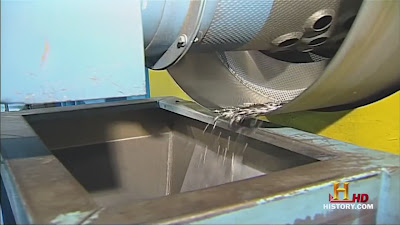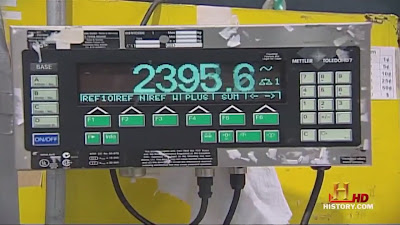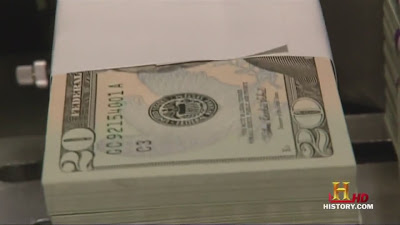



For more information about Mint : Wexler's Coins and Die Varieties










work.

He uses the brush to ensure there is no bubble trapped and detailed to the rubber mold.

Coin Hub/Coin Hubbing.
A hub is a positive, or relief (raised) image of the coin which has been impressed into a steel die during the process of creating coin dies. The original coin image is actually a plaster sculpture about 8 to 12 inches in diameter, from which a Master Hub is created using a special process that reduces the image to actual coin size. This Master Hub, which bears a relief image of the coin design, is then copied into a select number of Master Dies, (which bear the negative, or incuse image of the coin.)
The Master Dies are then copied, using a special extremely high-pressure "squeezing" process which employs tremendous hydraulic force, to create the numerous Working Hubs (commonly called simply hubs.) Then, from the tens of thousands of Working Hubs, the mint creates the Working Dies, (commonly just called dies.) It is from these working dies that our coins are actually struck.
The coin image on the hub is always a positive, or relief image, and the image on the die is always a negative, or incuse image. In this way, when our coins are struck, we get the raised detail we expect on our circulating coinage.
The coin hub itself looks just like a coin die, with the exception of the relief image. It is comprised of a steel shaft with the image of the coin impressed into one end of it.
Master Hub -->> Master Die --> Working Hub --> Working Die
For more information : Hubbing Process - What is a Coin Hub ??

This bevel gear will rotate the epoxy model and the coin hub, it is like the automobile's
driveshaft drives the front and rear wheel simultaneously.

Mint's Reduction Lathe/Javier Reducing Lathe.
The resulting of epoxy model is hard enough to withstand the reducing lathe. They transfer the
contour of the large model to the head of the coin size steel cylinder.
The yellow horizontal arm (like the lever, the brass in the middle of the arm is the fulcrum)
moves in and out according to the contour of the epoxy model that make the other move in
and out craving the steel coin. This machine is complete mechanical, there is no computer no relay device.

Plaster Sculpture.
The French Portrait Lathe was a reduction tool that traced out the design on the galvano and engraved that design onto the face of a Master Hub. This process was a slow and tedious one taking anywhere from a day and a half to two days to complete the transfer of the design to the master hub. When finished, the master hub had the design in relief and the face of the master hub was the exact size of the coins that would ultimately be produced with that design.




reverse imagine of the hub.



conical shape head.



cylinder to flat with the hub.


In the earliest days at the U.S. Mint, from approximately 1792 through 1836, a Master Die for a given year and denomination was produced by a Mint engraver who carved the central design for a coin directly into the face of the master die. The design elements around the edge of the coin such as the mottos, stars, and date were not carved into the master die. The carved design was cut out of the face of the master die so it was recessed (incuse) on the face of the die.
This master die is not used to strike coins. Because of the number of coins for a given denomination that need to be struck in any given year, it was not feasible to use these hand engraved dies to actually strike coins. Using modern coinage as an example, in 1996 the Philadelphia Mint produced about 6.6 billion Lincoln cents. The average life of a Lincoln cent die is about 1 million coins. Some simple math will tell us that in 1996 the Philadelphia Mint alone would have needed about 6,600 Lincoln cent dies to strike the Lincoln cents produced that year. Of course in the earlier days of the Mint that we are examining here, the yearly mintages were much less than modern mintages. However, the life of a die was also much less than that of modern dies, so it was still very impractical to hand engrave the dies that would strike the coins.
Rather than being struck by the master die, coins are struck by Working Dies. The master die is used as a tool from which the working dies would ultimately be produced. When the engraver was finished carving the central design into the master die, the master die was taken to a machine known as a hubbing press. In the hubbing press the master die was placed above a blank steel rod. With great pressure the face of the master die was lowered and squeezed into the steel rod leaving the impression of the image on the master die on the face of the steel rod. The blank steel rod has a cone-shaped face to allow for easier metal flow into the recessed areas of the die when the pressure from the hubbing press is applied. The new steel rod is known as a Working Hub and it now has the design images in relief (raised) just like on the struck coins. The face of the working hub looks exactly like one side of a struck coin.



Blank coins











The inspector scrutinizes the coin, but it is impossible to inspect each coin during the process.







The First coin.
The first United States coin bearing the likeness of an Africa American was the
Booker T. Washington memorial half dollar. It was minted from 1946 to 1951.




imagine. It is reverse.






The federal Reserve estimates that the average life span of a one-dollar bill is just 22 months.


Crane & Co.
This company is a manufacturer of cotton-based paper products using in the printing of
national currencies, passports and banknote as well as in social, business, industrial and technical applications. From Wikipedia.

Cotton Paper
Cotton paper is made from cotton fibers. It is often made with fibers from recycled clothing and it is sometimes referred to as rag paper which reflects this fact. Cotton paper is strong and durable and is used to make banknotes. One feature of cotton paper is that it has a low acid content or is acid free (however it is worth testing or checking with the supplier before using it in a archival project). The smooth surface with a high level of absorbency makes cotton paper a superior surface to stamp on and it works well with many types of coloring media.
From About.com Rubber Stamping.
Certain cotton fibre paper is known to last hundreds of years without appreciable fading, discoloration, or deterioration, so it is often used for important documents such as the archival copies of dissertations or theses. As a rule of thumb, for each percentage point of cotton fibre, a user may expect one year of resisting deterioration by use (the handling to which paper may be subjected). From Wikipedia.



The factory which makes banknote is extremely humble, but you never detest it, never !!












































was the $100,000 Gold Certificate, Series 1943. It was used only for transactions between
Federal Reserve banks.






No comments:
Post a Comment